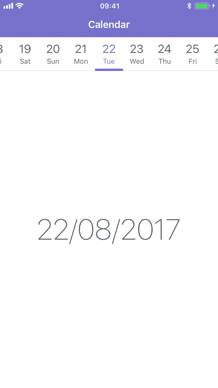If you’re creating something like a calendar, the number of view controllers can be infinitely large, or maybe you don’t know exactly how many items you need to display since you’re fetching them from the server as you are scrolling. In these cases you can use the PagingViewControllerInfiniteDataSource protocol.
Let’s look at how you can create your own calendar data source. This is what we want to achieve:
The first thing we need to do is create our own PagingItem to hold our dates. PagingItem is just an empty protocol that is used to generate menu items for all the view controllers, without having to actually allocate them before they are needed. You can store whatever data that makes the most sense for your application, the only requirement is that it needs to conform to Hashable and Comparable.
struct CalendarItem: PagingItem, Hashable, Comparable {
let date: Date
static func < (lhs: CalendarItem, rhs: CalendarItem) -> Bool {
return lhs.date < rhs.date
}
}Now that we have our custom PagingItem, we can create our PagingViewController instance:
class ViewController: UIViewController {
override func viewDidLoad() {
super.viewDidLoad()
let pagingViewController = PagingViewController()
}
}Then we need to conform to the PagingViewControllerInfiniteDataSource protocol:
extension ViewController: PagingViewControllerInfiniteDataSource {
func pagingViewController(_: PagingViewController, itemAfter pagingItem: PagingItem) -> PagingItem? {
let calendarItem = pagingItem as! CalendarItem
return CalendarItem(date: calendarItem.date.addingTimeInterval(86400))
}
func pagingViewController(_: PagingViewController, itemBefore pagingItem: PagingItem) -> PagingItem? {
let calendarItem = pagingItem as! CalendarItem
return CalendarItem(date: calendarItem.date.addingTimeInterval(-86400))
}
func pagingViewController(_: PagingViewController, viewControllerFor pagingItem: PagingItem) -> UIViewController {
let calendarItem = pagingItem as! CalendarItem
return CalendarViewController(date: calendarItem.date)
}
}Every time itemBefore: or itemAfter: is called, we either subtract or append the time interval equal to one day. This means our paging view controller will show one menu item for each day.
We then set our infiniteDataSource property and select our initial item. In this example, we want the current date to be the initially selected:
pagingViewController.infiniteDataSource = self
pagingViewController.select(pagingItem: CalendarItem(date: Date()))Finally, we add pagingViewController as a child view controller and setup the constraints for the view:
addChildViewController(pagingViewController)
view.addSubview(pagingViewController.view)
pagingViewController.didMove(toParentViewController: self)
pagingViewController.view.translatesAutoresizingMaskIntoConstraints = false
NSLayoutConstraint.activate([
pagingViewController.view.leadingAnchor.constraint(equalTo: view.leadingAnchor),
pagingViewController.view.trailingAnchor.constraint(equalTo: view.trailingAnchor),
pagingViewController.view.bottomAnchor.constraint(equalTo: view.bottomAnchor),
pagingViewController.view.topAnchor.constraint(equalTo: view.topAnchor)
])Check out the Calendar example target for more details
